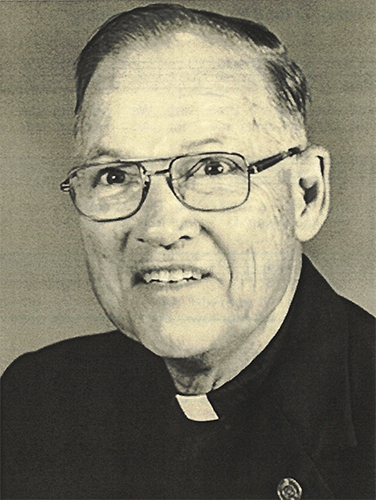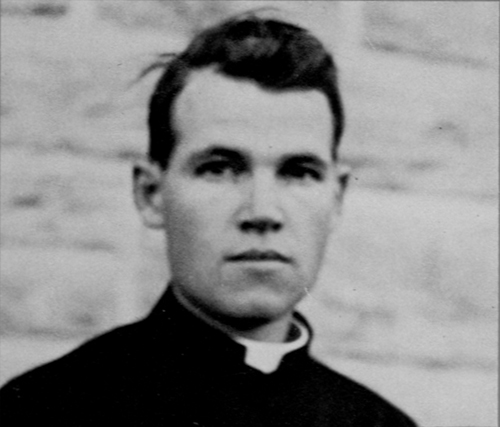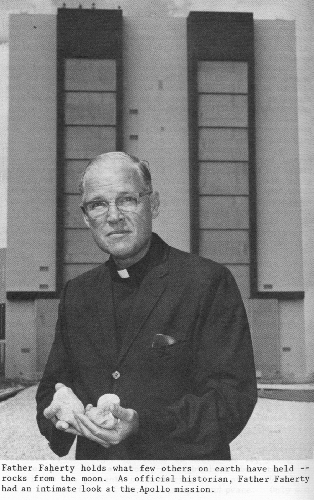St. Louis Cultural History Project—Fall 2021
Everyone’s Historian: William Barnaby Faherty, S. J.
By John Waide, M.A.

William Barnaby Faherty loved St. Louis. He was born here and nearly a century later, he died here. In between, he went to grade school, high school, and college in St. Louis, and he joined the Society of Jesus here. He would devote nearly 70 years of his life to the Jesuits. Although he studied for a time in Kansas and lived and worked for short periods in both Wisconsin and Colorado, Father Faherty spent virtually his entire life in the city that he loved. He really loved everything about St. Louis. He loved its architecture, its churches, schools, parks, restaurants, cemeteries, monuments, and sports teams. But most of all, Father Faherty loved the people of St. Louis and their histories. And his love for the people of St. Louis and their history was reflected most by the more than 50 books and over 100 articles he wrote about those people and that history. Here is the tale of this remarkable Jesuit priest, and of his tireless efforts to promote the story of his home and its people, St. Louis.
William Barnaby Faherty was born on December 17, 1914, in his parents’ home at 6635 Arsenal Street, on the north side of the street just east of Jamieson Avenue. The home was a half-block from Longfellow Public School and a block from Epiphany Church and School. Louise, his sister, was born a year and a half earlier on May 1913, and they had a younger brother, Daniel.
His father, William, was born in 1874 to a large Irish farm family in Ruma, Illinois, where he went to a one-room school. He later attended college for a while in Valparaiso, Indiana. He completed the business course at Christian Brothers College in St. Louis at Kingshighway and Easton Avenues. He took a job at Urbauer-Atwood Heating. He met Angeline Barby, a secretary, who was neither Catholic nor Irish. They were married at St. Ann’s Church in St. Louis in 1911.
Faherty completed kindergarten at Longfellow School, but he took all of his remaining grade school at Epiphany School. Although his father had attended CBC, his mother had received her Catholic instructions from a Jesuit priest, so she wanted her son to receive a Jesuit education. Thus, William Faherty attended St. Louis University High School, which was now located on Oakland Avenue a little west of Kingshighway.
Faherty would later remark that the first notion that he might be interested in the priesthood occurred during his senior retreat at St. Louis U. High. Faherty said he was so impressed by what the retreat master told the young men that he decided to enter the Society of Jesus when he graduated. This retreat master who inspired young William Faherty was Father William Bowdern, S. J., who would later be known as The Exorcist
as it was Father Bowdern who conducted the Catholic rite of exorcism on a young boy in 1949. Faherty would encounter Father Bowdern again in a few years during his Jesuit preparation.
William Faherty entered the Society of Jesus at St. Stanislaus Novitiate in Florissant in September 1931. As he had advanced a grade at Epiphany School, he was only 16 years old when he graduated from high school and entered the Jesuits. Faherty’s novice years at St. Stanislaus were typical for a young Jesuit at the time, following a very regimented routine day after day. It was during his second year as a novice that William Faherty participated in what was called hospital probation.
He was sent to work at St. Mary’s Infirmary which had just become a Black.
hospital in St. Louis with primarily Black doctors and White nurses, most of whom were Sisters of St. Mary’s. Later in life, Father Faherty reflected on one of his experiences at the hospital. Faherty remarked that growing up in Epiphany Parish and attending St. Louis University High School, he had not known any Black people. While he and another Jesuit novice were observing an operation on a Black patient, they both noted that the Black patient was a person just like they were. Faherty said: As the lance [scalpel] split the skin, one could see how thin the Blackness was,
while his Jesuit friend remarked That much, and they’re just like us.
Faherty was always grateful for such an experience so early in his training as he knew it helped him be a better person, and priest, the rest of his life.
Faherty’s juniorate and philosophy years progressed in a typical fashion for Jesuits of the time. He took several history courses from Father Herbert Coulson, whom he considered the best teacher he ever had. Faherty completed his master's degree in medieval history at Saint Louis University in 1938, and his thesis was Medieval Monastic Economic history as Reflected in the Monastery of Stavelot in Belgium. After receiving his degree, William Faherty left St. Louis, spending the next three years as a teacher at the Jesuit’s Campion High School in Prairie du Chien, Wisconsin. Faherty struggled with his teaching during his first year at Campion, and he even considered transferring to a different seminary. But when he learned that almost every other young Jesuit teacher found teaching difficult at first, he gave up on the notion of changing seminaries, and he did become more confident with his teaching. It was while he was at Campion that Faherty learned to ski, a sport he enjoyed the rest of his life. He was also able to continue to ice skate, something he had learned while in St. Louis. During the summers at Campion, Faherty followed a formal reading program in American history which was directed by Father Joseph Donnelly, the noted Jesuit historian. Although Father Donnelly never taught Faherty in the classroom, Father Faherty forever considered Father Donnelly an historian mentor the rest of his career. It was also during his three years at Campion that Faherty found himself, along with several other Jesuit scholastics, in trouble with Father William Bowdern, his retreat master from several years earlier at St. Louis U. High and the current rector at Campion!
Faherty left Prairie du Chien and Campion in 1941 for his theology studies at St. Mary’s College in Kansas. It was while he was studying theology at St. Mary’s that William Faherty believed he learned how to be a good writer. Faherty felt that there were many good historians and many good writers, but he also believed there were not many historians who were good writers. At St. Mary’s, Faherty won two prizes for short stories he submitted to the Catholic Press Association Short Story Contest, and he was an active member of the St. Peter Canisius Writers’ Guild, which helped him get his first piece published in a magazine.
Father William B. Faherty, S. J., was ordained a Catholic priest in 1944 at St. Mary’s by St. Louis Auxiliary Bishop Paul Schulte, and he celebrated his first Mass shortly afterwards at Epiphany Church with Father John Francis Bannon delivering the homily. Father Bannon, who received his doctorate in American history from the University of California-Berkeley in 1939, had just been named the chairman of the Department of History at Saint Louis University. Father Bannon and Father Faherty would remain life-long friends.
During the Christmas holiday after he was ordained, Father Faherty was sent to help at an American military replacement training center in northern Texas called Camp Howze. There was a hospital located at the training center as well. While he was in Texas, Faherty met Father Charles Dismas
Clark. Father Clark would later become rather famous for his work with ex-convicts in St. Louis. Father Faherty also helped at Fort Riley in Kansas, where Father Claude Heithaus had been sent after delivering his famous sermon against racism and segregation at the St. Francis Xavier Church in St. Louis. Although Faherty knew of Father Heithaus, this was the first opportunity he had to meet him.
Father Faherty returned to Saint Louis University in the fall of 1945 to complete work for his doctorate in history. For the first time, he was able to study history exclusively, something that pleased Faherty very much. Although Faherty was certainly interested in American history in more general terms, he had a particular fondness for social history, even more particularly, women’s issues. As the Jesuits were focusing attention on social reform issues, Father Faherty’s interests were entirely in line with theirs. At Saint Louis University, the Society set up the Institute of Social Order, which brought together leading scholars and students on a variety of issues including industrial relations, labor issues, integration and racial justice, the role of women, and many others.
Father Faherty completed his Ph.D. work during the summer of 1948. As he had indicated his interest in women’s issues, the title of his dissertation was Recent Popes on Woman’s Position in Society. Soon after he finished his doctorate, Father Faherty was assigned to teach at the Jesuit’s Regis College in Denver rather than continue working in the area of social issues. He had some familiarity with Regis as he had taught there for one summer. Father Faherty enjoyed his years at Regis where he taught both history and sociology. He took advantage of the nearby ski slopes, and he was both the ski and swim coach at Regis. He even found time to serve as secretary for the Southern Rocky Mountain Ski Association! Father Faherty continued to write on various subjects. His first book, The Destiny of Modern Woman in the Light of Papal Teaching, grew from his dissertation research. It was published in 1950 while he was in Denver.

After spending eight years at Regis, Father Faherty was sent back to St. Louis where he was assigned to The Queen’s Work Publishing House and Sodality Center. His years at The Queen’s Work gave Faherty the time, and appropriate surroundings, to write. He took a short story that he had started at Regis called Commanche Moon
and expanded it into a book length piece. Heeding the advice of other writers who had reviewed the manuscript, he continued to add to the piece which eventually became known as A Wall for San Sebastian, published in 1962 by The Academy Guild Press. A few years later, in 1968, the book was made into a movie called Guns for San Sebastian, starring Anthony Quinn and Charles Bronson. The legendary Ennio Morricone composed the music for the film.
While at The Queen’s Work, Faherty published several research articles in historical journals as well as numerous pieces in more popular magazines. He also authored many short pamphlets published by The Queen’s Work, and he directed more than 100 retreats. He was a regular speaker on the Jesuit’s Sacred Heart Hour program on both radio and television.
In 1963, after seven years at The Queen’s Work, Father Faherty was assigned to the Department of History at Saint Louis University. The chair of the History Department was Faherty’s old friend, Father John Francis Bannon. The year after he came to the Department, Father Faherty had another book, Living Alone: A Guide for Single Women, published by Sheed and Ward. Although Father Bannon was not responsible for Father Faherty being named to the History faculty, it was assumed that Faherty and Bannon would collaborate on writing the University’s 150-year anniversary history which was coming in 1968.
Father Faherty did indeed write the University’s sesquicentennial history. The book was called Better the Dream—Saint Louis: University and Community, 1818-1968. In addition to his efforts towards the book, Father Faherty was involved in various other aspects of the anniversary celebration. While he was researching and writing the University history, St. Louis Archbishop Joseph Riter asked him to consider writing a history of the Archdiocese of St. Louis, and he agreed to do so.
Father Faherty taught history to thousands of Saint Louis University students during his 21 years on the active faculty before receiving emeritus status in 1984. Among the students in his classes were many of the University’s athletes, especially the soccer and basketball players. He even taught several players on Saint Louis University’s club football team during the late 1960s and early 1970s. Not to be outdone by those athletes he taught, Father Faherty remained active himself, snow skiing when he had the opportunity, and regularly swimming and playing tennis with friends. He would continue swimming and tennis well past his eightieth birthday! Father Faherty was well-liked as a history teacher, and he developed life-long friendships with many of his students.

While Father Faherty maintained a heavy teaching load at Saint Louis University, that did not deter him from his writing. Even though Faherty himself was never sure exactly how many books he authored, he estimated that he wrote more than 50 books and literally hundreds of articles and reviews. During his more than 75 years of writing, Father Faherty won scholarships to attend several writing schools, and his works were awarded numerous prizes, including several from the Missouri Writers Guild. Although much of what Father Faherty wrote was about historical subjects, and St. Louis history in particular, he did write about a myriad of topics. The book on the history of the Archdiocese of St. Louis which Cardinal Ritter had asked him to write was published in 1973 under the title, Dream by the River: Two Centuries of St. Louis Catholicism, 1766-1967. Although Father Faherty had hoped to be able to present the book to Cardinal Ritter as an 80th birthday gift in 1972, unfortunately Cardinal Ritter passed away a few years before. Later, in 1997, Faherty published a revised and expanded version of this history. In 1971, working in Florida with a young historian from the University of Florida by the name of Dr. Charles Benson, he began the research for a history of America’s Apollo space program. Their research eventually led to the publication in 1978 of Moonport: A History of Apollo Launch Facilities and Operations. His books about the Jesuits included Jesuit Roots in the Middle West (1980) and Men to Remember (1997), and he wrote another title about the Visitation Sisters, Deep Roots and Golden Wings (1982), and another book about the Alexian Brothers in St. Louis, To Rest in Charity (1984).
Faherty wrote extensively about St. Louis history. These titles included: Wide River, Wide Land (1976); The St. Louis Portrait (1978); St. Louis: A Concise History (1990); and Centuries of St. Louis, which he completed in 2007 while he recovered from a broken hip. His book about Henry Shaw, Henry Shaw: His Life and Legacies(1987), and another about the Missouri Botanical Garden which was created by Mr. Shaw, A Gift to Glory In (1989), were both well received and continue to be used by history students. In 2001, the Missouri Historical Society Press published Father Faherty’s The St. Louis Irish: An Unmatched Celtic Community. This title presents a comprehensive historical account of Irish immigration to the United States and the influence of the Irish in the St. Louis region. Faherty included a description of the journey taken by his own Irish ancestors first to Illinois and then to St. Louis in the 19th century.
Faherty also wrote several books about the Catholic Church. He considered the 1991 book, American Catholic Heritage: Stories of Growth, his favorite book. In this work, Father Faherty made the argument that the Vatican never understood the Catholic Church in America. He said: Rome has never allowed the church in this country to develop in such a way that it would reflect the American genius while remaining totally Catholic.
In 1998, Father Faherty expressed his views on various issues within the Church including women’s rights and Vatican politics through his novel, The Call of Pope Octavian, a fictional story about the selection of a new Pope after the unexpected retirement of Pope (now Saint) John Paul II. Father Faherty wrote about the German Catholic experience in St. Louis in his 2004 book The St. Louis German Catholics, and in 2009, working with Mark Scott Abeln, a St. Louis photographer, he published Catholic St. Louis: A Pictorial History.
In addition to his teaching and his writing, Father Faherty somehow found time for more activities. From 1980 to 2002, he was curator of the St. Stanislaus Museum on the site of the original Jesuit novitiate in Florissant, and from 1984 to 2000 he was the archivist for the Missouri Province Archives, later known as the Midwest Jesuit Archives in St. Louis, and he remained Archivist Emeritus until his death. For several years, he presented a very well-received short program called Catholic St. Louis
on a local Catholic radio station. Father Faherty was regularly invited to deliver public programs on some topic of local history, and he was always excited to be able to speak with people about the history of the St. Louis region.
After Father Faherty broke his hip in 2007, his health slowly declined. Although he continued to work on historical writing and his Catholic radio program, he was not able to get out of his Jesuit Hall residence as much as he had in previous years. On Friday, August 19, 2011, Father Faherty was taken from Jesuit Hall to Saint Louis University Hospital where he passed away on Monday, August 22, at the age of 96. His memorial Mass was held at St. Francis Xavier Church that Wednesday, and he was buried in the Jesuit section at Calvary Cemetery on Thursday, August 25, the feast day of Feast of King St. Louis IX of France, the patron of the City which he loved so much.

